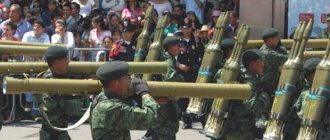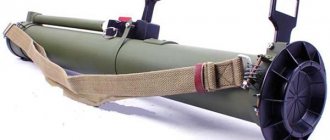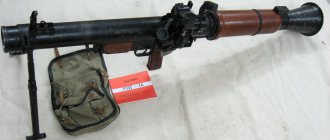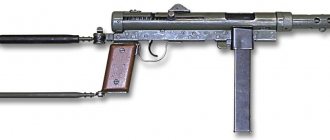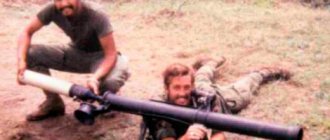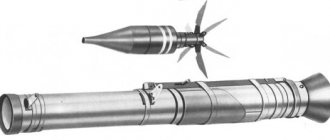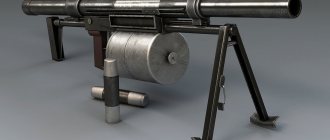Anti-tank grenade launcher Carl Gustaf (Sweden)
Anti-tank grenade launcher Carl Gustaf M2 (Swedish index m/48).
Anti-tank grenade launcher Carl Gustaf M3 (Swedish index m/86).
Carl Gustaf M2 anti-tank grenade launcher, breech with nozzle folded back for loading.
A Canadian soldier loads a Carl-Gustaf M3 grenade launcher.
Two of the many types of ammunition developed for the Carl-Gustaf grenade launchers - on the left, a high-explosive armor-piercing grenade (HEAT), on the right, a high-explosive fragmentation grenade (HE-FRAG) with a remote fuse, both developed by the Belgian company Mecar.
| Carl Gustaf m/48 - M2 | Carl Gustaf m/86 - M3 | |
| Caliber | 84 mm | 84 mm |
| Type | dynamo-reactive (recoilless) | dynamo-reactive (+ rocket booster on some types of grenades) |
| Length | 1130 mm | 1130 mm |
| Weight (with optical sight) | 14 kg | 9.5 kg |
| Effective firing range | 150 meters against moving targets 700 meters against stationary targets | 150 meters against moving targets 700 meters against stationary targets 1000 meters against stationary targets when using active-reactive grenades |
| Armor penetration | up to 400 mm | more than 500 mm + dynamic protection |
Swedish engineers began developing hand-held, shoulder-fired anti-tank weapons in the early 1940s. Their first development was the 20mm m/42 anti-tank rifle, which was put into service in 1942, built on the recoilless principle and fired armor-piercing blanks. The effectiveness of such ammunition against tanks was already minimal by the middle of the Second World War, and therefore in the mid-forties the Swedes switched to a recoilless system that fired caliber armor-piercing ammunition with a cumulative warhead. In 1948, the Swedish army adopted a single-shot dynamo-reactive (recoilless) grenade launcher m/48 of 84mm caliber, the full name “Granatgevär 8.4cm m/48Carl-Gustaf”. In subsequent decades, the Carl-Gustaf grenade launcher (named after the Swedish king) became the most widely used in the world, thanks to its simple design and wide selection of ammunition. In addition to anti-tank cumulative grenades for Carl-Gustaf, high-explosive fragmentation and shrapnel ammunition for combating enemy infantry, incendiary, smoke and illumination grenades, special training sub-caliber modules, etc. have been developed and produced around the world. In the mid-1980s, the Carl-Gustaf grenade launcher underwent the only more or less serious modification - the steel barrel was replaced with a much lighter composite one, consisting of a thin-walled steel liner and an outer shell made of fiberglass. However, even in this version, adopted in Sweden under the symbol m/86, and in the world known as the Carl-Gustaf M3, the total weight of the system is significantly greater than that of its main competitor, the Soviet RPG-7 grenade launcher. In addition, loading from the breech significantly complicates the use of Carl-Gustaf grenade launchers by one person - the regular crew of a grenade launcher consists of two people, a shooter and a loader. However, Carl-Gustaf grenade launchers are in service with dozens of armies around the world, including Belgium, the USA, India and many others. Ammunition for Carl-Gustaf is also produced not only in Sweden, but also in Belgium and India.
The Carl-Gustaf grenade launcher is a single-shot dynamo-reactive weapon with a rifled barrel. The barrel at the rear is open and equipped with a hinged breech with an exhaust nozzle. For firing, unitary shots are used, consisting of a grenade and an aluminum casing. The cartridge case in the rear part has a knock-out plastic bottom, which first provides the necessary boost pressure when firing, and then the outflow of powder gases from the barrel back through the nozzle for recoilless shooting. The primer for igniting the powder charge is located on the side surface of the cartridge case at the bottom; to ensure alignment of the primer with the striking mechanism in the barrel, there is a special chamfer on the rim of the cartridge case, allowing it to be loaded into the barrel in only one position. For loading, the breech with the nozzle is tilted up and to the left around the longitudinal axis. If the breech is not completely closed, a shot is impossible. Under the barrel there are two pistol grips (front for holding and rear for fire control), a mechanical trigger mechanism with a manual safety, a shoulder rest and a bipod support. On the left side of the barrel there is a folding open sight in the form of a front and rear sight, as well as a bracket for mounting an optical sight (2X magnification for Carl-Gustaf M2 and 3X for Carl-Gustaf M3). To increase the effective firing range in recent decades, active-reactive rounds have been developed for Carl-Gustaf M3 grenade launchers, which have an additional rocket grenade accelerator, which is turned on after the shot at a distance of 10-30 meters from the shooter.
Getting to know the gun
You may be interested in: Bulldog grenade launcher: device and performance characteristics
The M/48 Granatgevar Carl Gustaf is a Swedish hand-held anti-tank dynamo-reactive (recoilless) grenade launcher, which allows for reusable use. The Carl Gustav grenade launcher has been in service from 1948 to the present.
About modifications
The 1948 Carl Gustaf M1 grenade launcher is the base model. It served to design the following samples:
- Carl Gustaf M2 is considered a more advanced model. Developed in 1964. Swedish designers managed to reduce the weight to 14 kg. The anti-tank hand gun is equipped with a double optical sight. In the technical documentation it is listed under the index M2-550 or FFV 550.
- M3 (Grg m/86) is the third model produced in 1991. Weapons engineers replaced the steel barrel with a thin-walled liner (rifled steel liner), which was mounted in a fiberglass casing. Thanks to this design solution, the weight of the grenade launcher is reduced to 10 kg. Similar to the American M16 automatic rifle, the Grg m/86 was equipped with a special carrying handle. This sample has an improved three-fold optical sight.
- M4. Represents the fourth improved model of 2014. The Carl Gustav M4 grenade launcher weighs no more than 6.8 kg. Unlike the previous version, the M4 uses a liner that is made of titanium. The material for the casing was carbon fiber.
About the device
You may be interested in: Hunting from the approach: concept, opening of the season, permission and advice from hunters
The Carl Gustav grenade launcher is a single-shot, dynamo-reactive anti-tank weapon that produces minimal recoil when fired. Grg m/48 has a rifled barrel, a mechanical firing mechanism, for which a manual safety is provided. In order to ensure convenience during shooting, Swedish gunsmiths introduced two pistol grips into the design of the grenade launcher. The front grenade launcher is held by the fighter. The fire is controlled using the rear handle. In addition, the design of the anti-tank gun includes a shoulder rest, a bipod and a special handle by which the Grg m/48 is carried. The location of the trigger mechanism was the right side of the grenade launcher, and the folding mechanical sighting devices were located on the left. The grenade launcher on the left is equipped with a special bracket, through which the weapon can be equipped with an optical sight using a laser rangefinder. A standard combat crew has two people: a shooter and a loader.
If you need to fire one shot, then one fighter can do it. Loading the grenade launcher begins with tilting its breech. To do this, lift it up and move it to the left. In order to prevent unplanned shooting, Swedish designers installed a special fuse in the anti-tank gun. If the bolt is not completely closed after loading ammunition, the shot will not be fired.
Major wars
At the beginning of the First World War, he served as a cavalry commander on the Austro-Hungarian and Romanian fronts. In December 1914, he was awarded the St. George Cross, one of the highest awards of Imperial Russia.
He fell ill after the accident and returned to Finland, arriving in December 1917. Around the same time, Finland was involved in a merciless civil war between Reds and Whites. He was the leader of the white army that crushed the reds. Germany supported the Whites, while Soviet Russia supported the Reds. By the 1930s he was determined to bridge the gap between Reds and Whites and succeeded in winning the trust of the Social Democrats.
In which countries is it used?
According to experts, besides Sweden, several dozen countries have Carl Gustaf manual recoilless rifles. In Great Britain, these grenade launchers replaced the American M20 guns, also called “bazookas,” in 1964. The British used Swedish grenade launchers until the 1980s. Since that time, the English infantry has carried out fire missions using LAW80 disposable grenade launchers. A similar situation has developed in Japan. There, Swedish grenade launchers replaced American bazookas in 1979. In addition, gunsmiths in Japan are engaged in licensed production of Carl Gustaf. The gun is listed as FT-84. In 1970, the first experimental batch of Swedish hand-held anti-tank guns was purchased by the United States. 20 years later, the Carl Gustaf was adopted. Among American soldiers, the weapon is known as the RAWS M3. In addition to Sweden, Japan, Great Britain and the USA, the armies of Australia, Austria, Belize, Brazil, Greece, Denmark, India, Ireland, Canada, Kuwait, Latvia, Lithuania, Malaysia, Nigeria, Libya, New Zealand, Poland, Portugal have modifications of the Carl Gustaf , Estonia, Chile, etc.
Source
About the history of creation
The basis for the Carl Gustaf grenade launcher was the Pvg m/42 Carl Gustaf anti-tank rifle, widely used by soldiers of the Royal Army during the Second World War. The first development had a caliber of 20 mm. Armor-piercing blanks were used as shells.
However, it soon turned out that such ammunition had low effectiveness. Therefore, the Swedes focused their attention on a recoilless system that could use caliber armor-piercing projectiles with cumulative warheads. Swedish design engineers Gerald Jentzen and Hugo Abrams worked on the design of the new weapon. Like the m/42, work on the new grenade launcher was carried out at the Stads Gevarsfaktori Carl Gustaf factory. In 1948, the first model of the Carl Gustaf M1 anti-tank gun was released. In the same year, the Swedish army was armed with it.
About purpose
Using the Carl Gustav grenade launcher (photo of this weapon below), armored targets, fortifications, equipped and unequipped enemy firing positions are destroyed. In addition, using Grg m/48 they set up smoke screens and illuminate the area. Also, the Carl Gustav grenade launcher is used in cases where it is necessary to eliminate large concentrations of enemy personnel.
You may be interested in: Carbine "Vepr 223": model range, description, manufacturer and performance characteristics
Military career
After graduating from the Nikolaev Cavalry School in 1889 in St. Petersburg with honors, he immediately received an officer rank. From 1987 to 1917, Karl served Russia and rose from cornet to lieutenant general.
So, in 1891 he joined the cavalry guard in St. Petersburg and soon became a cavalry captain. Until 1904, he served in the Imperial Cavalry Guard, even taking part in the coronation of Nicholas II. In October of the same year, he was promoted to lieutenant colonel and was transferred to the 52nd Nezhin Dragoon Regiment in Manchuria.
He was promoted to colonel after participating in the Battle of Mukden and the Russo-Japanese War. Traveling on horseback, he led an expedition to China from July to October 1906 together with the French scientist Paul Pelliot.
What does the gun fire?
Target destruction from the Grg m/48 and its modifications is carried out using unitary ammunition, the design of which includes a grenade and an aluminum casing. Its rear part is equipped with a plastic expulsion bottom, the task of which is to provide the projectile with the necessary pressure in the initial stage of the shot, and then release the gases through the nozzle. At the bottom of the cartridge case on the side there is a place for the ignition primer. To align the firing mechanism with the primer, a special chamfer was placed at the edge of the cartridge case, thanks to which the ammunition, when entering the barrel, occupies one single position. According to experts, a wide variety of ammunition has been created for the Grg m/48 and its modifications.
As a result, this weapon is considered a multi-purpose grenade launcher system, and not a purely anti-tank one. Thanks to this fact, “Carl Gustav” is very popular in the armies of many countries. Due to the versatility of the grenade launcher, infantrymen can use it to solve a wide range of combat missions.
This gun can be fired with anti-tank, multi-purpose, tactical, anti-personnel, auxiliary, training standard and sub-caliber ammunition. HEAT, high-explosive fragmentation, shrapnel, smoke, lighting and other types of grenades have been developed for them. The manufacturing countries of such shells were Sweden, Belgium and India.
